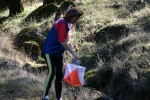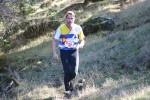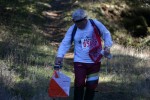RouteGadget
Maintained by
For several years, most major Finnish orienteering events have offered an online utility, RouteGadget (http://baoc.org/gadget/cgi/reitti.cgi), for competitors to draw and compare their routes. RouteGadget not only shows the routes, but when linked with E-punch results, it allows the race to be replayed, even simulating a mass start. You will actually see little squares run across the map. It really adds another dimension to post-race analysis.
After our Calero event in 2004 I thought that the Chase would be an ideal race to be replayed with RouteGadget. So, I contacted RouteGadget developer, , in Finland to find out in what terms he would let us try RouteGadget. It turns out that he developed it as a hobby and offers it free for non-commercial use. Jarkko has also been very helpful in tuning RouteGadget for our needs. For example, as RouteGadget didn't support SI e-punch file format, he was happy to develop that feature—not to mention all the little bugs he has fixed along the way.
RouteGadget is now available here (http://baoc.org/gadget/cgi/reitti.cgi) on the BAOC website—I have set up many events with it. RouteGadget can be used on a PC or Mac, with most browsers.
Note that RouteGadget has an option to use the splits file to determine the order in which each competitor visited the controls. This is prefect for Score-Os, Goats, butterfly loops, etc.
Sections below explain how to use RouteGadget to view other peoples' routes and how to enter your own route. Also, there's a "functionality walkthrough" video (http://routegadget.net/download.cgi) that demonstrates the many features (there's no audio—pay close attention to the pointer).
You can see other RouteGadget events worldwide by visiting this website (https://www.routegadget.net/index.php?stay).
RouteGadget No Longer Uses Java
I'm pleased to report that I have upgraded our RouteGadget to the latest Java-free version. With its touch-friendly user interface, the new version also runs on mobile devices. And, most importantly, our event database of 11+ years, with 370 events and 6000+ routes, is compatible with the new version. – Tapio (February 8, 2016)
How To View Routes
RouteGadget is quite intuitive and easy to use. It also has its own set of instructions. Here's a short summary to give you a quick start:
- First you need to select an event. If you use the "This Event" link on the results page for an event, that event will be selected for you.
- To view a race animation, you need to "Choose class/course" and select the desired course.
- You can move the map around by pressing and holding down the left mouse button somewhere on the map while moving the mouse in the desired direction. Now, locate the Start triangle. (Note that for a Score-O or Goat event, the course will not be displayed until you select one or more competitors and one of the "View" options.)
- Next, choose competitors whose routes you would like to view. You can select up to 10 people who have drawn their routes (indicated by an asterisk next to their name).
- To start the animation, press the "Load animation" button, select the "Mass start" option (on by default), and press the "Start" button. Small squares representing the different competitors should start from the triangle.
- During the animation you can move and zoom the map. You can also increase/decrease the animation speed with the "Speed+/Speed−" buttons. Moving the pointer to one of the small squares will open a flag that identifies that person.
- You can also view the competitors' routes, splits, and comments.
Special Note for Viewing the 2004 Calero Chase
To replay the real Chase in the 2004 Calero "Chase" event (http://baoc.org/gadget/cgi/reitti.cgi?act=map&id=1&kieli=), you need to combine the "Green Right" and "Green Left" courses. You can do this by selecting "All classes" from the "Choose class/course" menu. There is one drawback, however—the current RouteGadget version does not identify the courses in this mode, but the animation still works fine.
How to Draw Your Route
Drawing your own routes is equally easy. Simply follow the instructions at the bottom of the RouteGadget page. Here's some additional suggestions:
- RouteGadget spreads your time out evenly along the route that you draw for each leg. This may not be accurate, particularly if you had trouble with any part of the leg. If you wandered around in some location, make sure to include a lot of fine detail in your drawing, even if you don't know exactly where you were. This will appear to slow the animation in that area (and not on the part of the leg where you did well). You can also artificially introduce a pause, if, for example, you stood for a minute relocating. You can show this by creating a small tick mark across your route and oscillated back and forth in place on the tick mark for awhile when you are drawing the route. Then the animation will also appear to pause at the same location.
- In some cases the routes will speak for themselves, but there is also a comment field for you to use. You can type in the comment field when you think of things while you are drawing your route. This can be particularly helpful for beginners looking at the animations and wondering what was going on. Was the route planned or accidental? If it was planned, what was the thinking? Make sure to include the leg number in the comment, since the comment is associated with the entire course. For example:
- 1-2: Aimed for the fence corner to use it as an attack point.
- 4-5: Accidentally drifted much lower than planned. Saw the road and turned.
- 5-6: The undergrowth seemed much slower than mapped. So I switched to the stream bed for a faster route.
- 9-10: Was planning to use the trail bend to attack, but found the boulder and used that instead.
- As the RouteGadget administrator, I can remove your route if you realize that you made a drawing mistake after having saved it. Just let me know.
If an event did not use e-punch, the event is set up in RouteGadet using the "no results" mode, where competitors need to enter their name, total time, and any cumulative splits they might have taken.
- You can draw your route even if you didn't take any splits, just enter your name and total time. Note that if you are uploading a GPS track (see below), you don't need to enter your total time or splits.
- Note that RouteGadget requires cumulative splits. Both splits and total time need to be in MMMSS format. For example, 0:57 is entered as "57", 5:43 as "543", and 1:12:32 as "7232".
How to Upload GPS Tracks to RouteGadget
As an alternative to drawing your route manually, if you wear a GPS tracking device you can upload your GPS track to RouteGadget. To do that, you need to open the GPS upload interface in RouteGadget by clicking the "GPS" link on the upper right-hand corner next to the "Help" link.
The first thing you do is to select the GPS format. As you can see, RouteGadget supports several formats, with GPX being the most generic. That's what I use to import my routes from my Garmin 405 GPS watch. (I first upload the track to SportTracks (http://www.zonefivesoftware.com/SportTracks), which can export GPX files. SportTracks is only for PCs—the Trial Version (http://www.zonefivesoftware.com/sporttracks/store/compare.php) is free.)
- Note: Although RouteGadget supports several GPS formats, most people convert their files to GPS eXchange (.GPX) format, which is supported by RouteGadget. Whatever GPS program you use, it most likely allows you to export files in .GPX format. That's your best option.
From the GPS upload interface you can also open a GPS help page (http://www.routegadget.net/grgpshelp/) that is also very helpful.
Note that I typically add a point to every control to adjust my route properly.
The following write-up from Brad Wetmore gives more details:
- I'm using a Garmin 305 and SportTracks to log most of my runs. The software included with the Garmin is quite limited—I just like SportTracks much better. I also need SportTracks to output my data to a GPX file.
- Here are the steps for uploading to RouteGadget:
- Download your route into SportTracks.
- Export → GPX. Enter a file name and save the data.
- Start RouteGadget (e.g., using a link on the event's Results webpage). Wait for the map to be displayed.
- Click "GPS upload" at the top of the right-hand panel.
- Select the course you ran.
- Select your name.
- Browse to the desired file on your computer.
- Under "Calibration", select "Splits based" (i.e., the default).
- Click "OK" to import the file into RouteGadget.
- Note: "Splits based" calibration automatically makes the route exactly visit all the controls. "Manual" calibration does not do that, so you have to adjust the entire route.
- Here are some tips to adjust your uploaded route:
- You should see the course with your route drawn in red. Your route should be shown as visiting all the controls.
- Zoom out until you see the entire course.
- Some maps are dead on and you're done, others take a bit of adjusting.
- If your route seems significantly incorrect, you can experiment with the "Offset" slider, which compensates for the difference between when you started your watch and when you punched the Start unit.
- For most of our local events, the offset should be set to 0, as we start from the triangle. The offset can have a huge impact on your route accuracy.
- Now you can make adjustments to your route to correct it. I generally start at the Start, adjusting as I go. Right click on your route to add a point, then drag that point to where the route should be. (You can delete a point by right clicking on it.)
- You might see that nearby portions of the route get distorted—add more points to make more adjustments.
- If you have a path that is good up to a location that isn't a point, just add a point there, and then future adjustments will not affect that point.
- After you have adjusted your entire route, you click on "Save" to have the route stored in the system. Note: After that, you cannot modify the route.
- I hope that makes sense.
- – Brad
Recent Problem Uploading to RouteGadget
A user reported the following problem:
- I am trying to draw my route for Huddart using GPS import. I have saved the file to GPX format. I click import GPX file, choose my course and my name, and then select the box file using the browse button. But then only the locations of the controls show up, not the route.
Here's the explanation and solution:
- It turns out that the GPX route included some bogus (latitude="0" & longitude="0") track points. Talking to Jarkko, the RouteGadget developer, the bogus points started appearing on some Garmin devices this fall after a recent Garmin Connect update. Many users have filed bug reports to Garmin, but it's unclear if they will fix the bug. (RouteGadget could be patched to ignore these bogus points.)
- For now, you can remove the (latitude="0" & longitude="0") track points from the beginning of your GPX file. You can use any text editor (e.g., Windows Notepad, Mac TextEdit). The track points look similar to the following (note the zeros in the first line):
- <trkpt lat="0" lon="0">
- <ele>0</ele>
- <time>2016-10-16T17:07:55.000Z</time>
- <extensions>
- <ns3:TrackPointExtension>
- <ns3:hr>85</ns3:hr>
- <ns3:cad>0</ns3:cad>
- </ns3:TrackPointExtension>
- </extensions>
- </trkpt>
- <trkpt lat="0" lon="0">
- Deleting the bogus track points fixed the problem for the user.
- This issue is discussed on Attackpoint (http://attackpoint.org/discussionthread.jsp/message_1195273#message1197806) in case anyone is interested in more details.
- – Tapio (October 24, 2016)
For Course Setters: What kind of files are needed?
Now that RouteGadget is installed on our Web server, it's quite easy to set up new events. All that is needed are the following 3 files:
- A JPEG or GIF image of the map, which can be exported from OCAD. Specs for the image are:
- Resolution should be 100–200 dpi.
- Dimensions should not be larger than 1700x1700 pixels.
- File size should not be much larger than 500 KB for fast download. Thus, the image should be of only the immediate competition area. For example, the Calero map image is 200 dpi, 1800x1300 pixels, and the file size is 650 KB.
- Condes course data in XML format. Condes has an export option for doing this.
- SI E-punch splits in CSV format (semicolon separated).
RouteGadget has a layout tool that allows the courses to be placed over the map. This takes a few iterations, but is quite easy.
That's all there is to it, RouteGadget handles the rest.
Let me know if you have any problems. Go to RouteGadget (http://baoc.org/gadget/cgi/reitti.cgi).
Enjoy!
– Tapio




